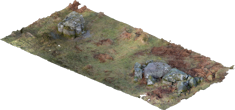
Achnacreebeag (NM92963639) is a Neolithic chambered cairn in Argyll and Bute, Scotland, consisting of two burial chambers, which were covered by a stone mound (Ritchie 1973). Achnacreebeag has been particularly important in terms of national debates concerning the first Neolithic societies in Britain and Ireland (e.g. Sheridan 2012; Whittle et al. 2011). However, interpretation and visualisation of the site in the contemporary literature relies heavily on plans generated as part of the mid-20th century excavation (Ritchie 1973, 32). The dimensions and location of the site are directly relevant to its importance. Never before has a 3D colour representation of the monument been available to aid in its interpretation.
Achnacreebeag was recorded by members of the team as part of our wider work on comparable sites for the north Wales monuments, which includes contributions from members of the public from Orkney, Jersey, and salaried members of the team in Ireland and Scotland. It presented a number of site-specific recording issues such as the presence of water on the site (which produces 'bounce') and rainy conditions (which present the usual photographic constraints). The creation of the model of the site has wider implications for public archaeological research and dissemination. The potential impact of digital photogrammetry on archaeological research should be noted here. Relatively limited or small surveys can result in important archaeological models; individual contributions from citizen scientists have the potential to have disproportionately large impacts on our understanding of the archaeological record.
For the model presented here (Figure 5), relatively few images were employed; 195 photographs were used in this instance. Additional photographs were taken by a member of the team on a Neolithic Studies Group trip with a scale to generate metric data. Higher resolution models are not directly dictated by the number of photographs (though a minimum number are required to guarantee coverage and a fully 3D model), but by the resolution of the images used to generate the model. In order to afford maximum resolution, the distance from the subject being photographed and the use of a high-resolution digital camera (higher than 12 megapixels) are key. Accounting for these criteria, digital public archaeologists can produce timely, significant and important research using relatively limited resources.
